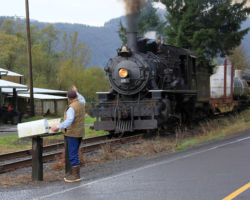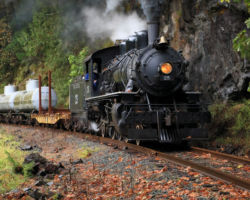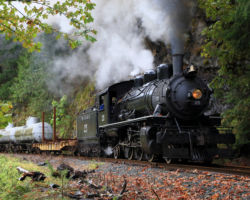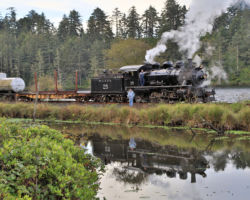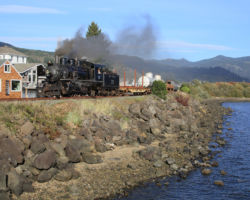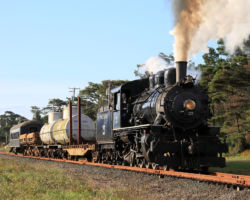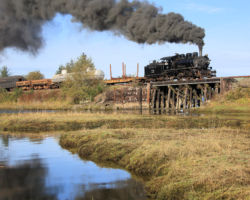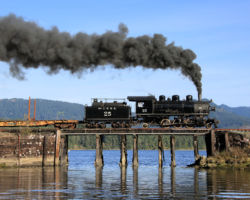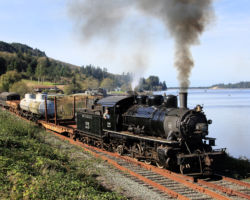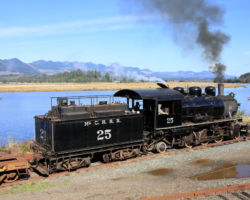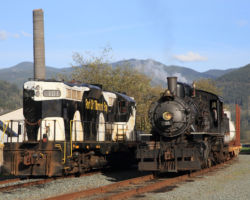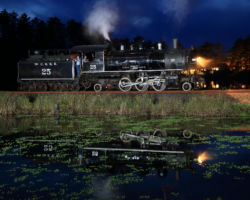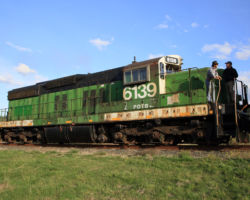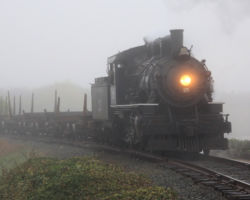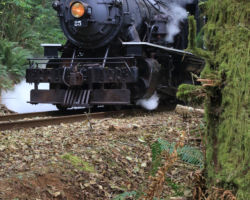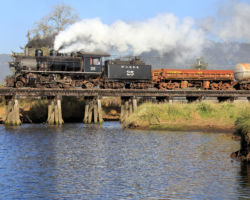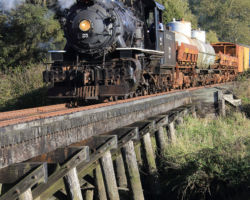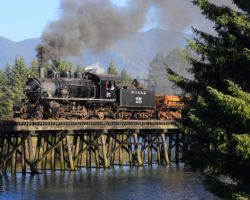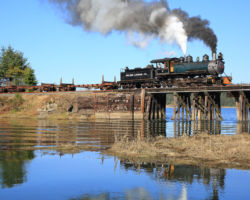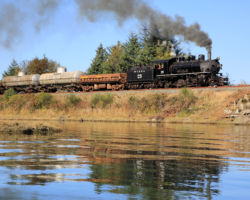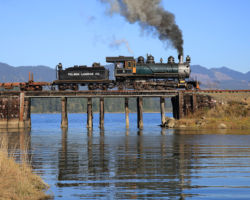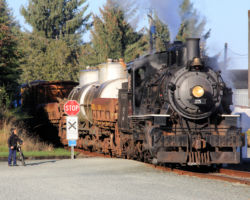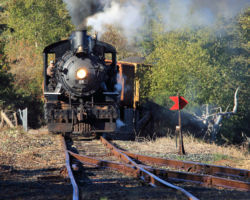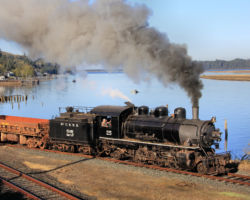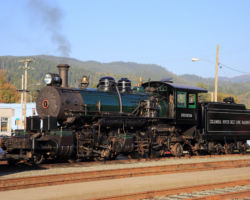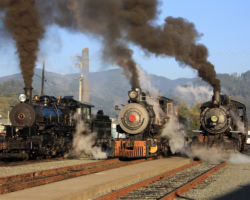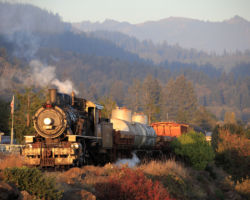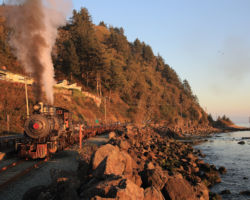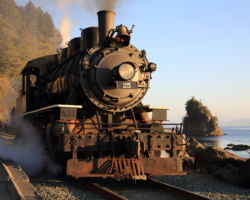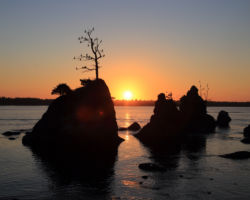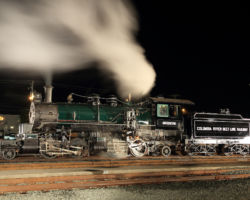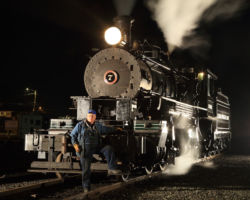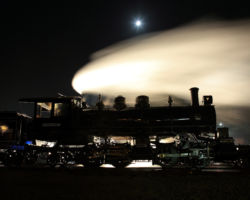In October of 2014 and 2018, Pete Lerro and Lerro Productions ran a series of photo charters in the Pacific Northwest, each including a couple days on the Oregon Coast Scenic Railroad – the former SP Tillamook (and later Port of Tillamook Bay) line.
Oregon Coast Scenic History
The OCSR track began life as the Pacific Railway and Navigation Company in 1906. The PR&N was technically independent, but very much a product of Harriman and Southern Pacific interests. Construction started from both ends, and Tillamook-Salmonberry became operational in 1909. The through route was finished in 1911, and in 1915 it was folded into SP.
The Port of Tillamook Bay Railroad was only ever intended to be a switching line, servicing an industrial park being developed around the US Navy’s former blimp hangers at the Tillamook Air Station. Operations slowly extended north, and in 1981 the POTB was servicing everything from Wheeler to the end of the line. By 1986, the POTB was operating the entire route to Hillsboro using trackage rights.
The Tillamook line was always a headache. It passed through narrow canyons of soft soil, and with the Coastal Ranges getting an average of 90 inches of rain a year, landslides and washouts were all too common. The SP really wanted to be rid of these expensive branches, and applied to abandon the route in 1989. After the SP fixed significant storm damage in January 1990, the POTB and State of Oregon stepped forward to purchase the entire route for $2.9M.
A change in ownership did not change the geology nor the weather. In February 1996, winter coastal storms caused significant damage, with 7 miles of track along the Salmonberry River between Enright and the summit “completely destroyed”, including the loss of two bridges. The 1996 damage ran in the $12M range, but the railroad was repaired with the help of state and federal aid monies.
The end for freight operations came on December 2-3, 2007, when what’s become known as the “Great Coastal Gale” struck the area with hurricane-force winds and torrential rainfall. Once again, the track along the Salmonberry was undermined or covered for miles, three bridges were damaged, and one tunnel was blocked with mud and debris. Repair estimates started at $30M, but when more detail was considered rose to nearly $57M. With this large looming number, the Port, still in debt from the 1996 repairs, decided to discontinue service on the line except for the OCSR operations on the coastal section.
The Oregon Coast Scenic Railroad was started in 2003 by Scott and Kim Wickert. The goal was to offer steam-powered excursion runs over the coastal section between Tillamook, Garibaldi, Rockaway and Wheeler, in partnership with the POTB operations. The line started operations with Scott’s Curtiss Lumber Co. 2, a 1910 2-truck Heisler, but the operation has proven popular and continued to grow over the years, both in equipment and clientele. With the end of freight operations in 2007, the OCSR became the only user of the line, and 2012 secured a 15 year lease of the line (with a further 5 year option) for the 46 miles between Tillamook and the Salmonberry River.
That’s not to say the line’s future is perfectly secure, however. The winter season can be rough on the track structure, and there are those who would like to see the rails removed and converted to a trail. Fortunately, it looks like at least at the moment, the parties agree that it should be rail and trail over the operating section. All I can say is please support this remarkable and unique little operation. It’s a true gem for railroad enthusiasts and the local economy.
2014 Trip
The 2014 OCSR charter was actually one of a series, including other days on the Mt. Rainier, the Chelatchie Prairie, and the Oregon Pacific with the SP&S 700. It also lined up with the Sumpter Valley’s fall photo trip, scheduled for the weekend afterwards. I honestly can’t remember exactly why I decided to go on the 2014 trips, but something about it just struck me as an opportunity not to be missed.
Because of commitments here in Colorado (namely the Rocky Mountain Railroad Club’s annual banquet, of which I was still president at the time), I had to skip the Mt. Rainier charter. However, immediately following the banquet in Denver on Saturday, October 11, I traded my suit and tie for my usual jeans and black t-shirt and drove out to the airport, catching a late flight to Boise, ID. From Boise, I’d have the entire next day to drive out to Vancouver, WA, to be ready for Monday’s Chelatchie Prairie trip. Then another day of down time (which I’d spend bugging a few friends around Portland), and then out to Tillamook for the start of the OCSR trip on the 15th. I’ll cover the Chelatchie Prairie and the Sumpter Valley parts of the trip in other reports. This will purely focus on the two days (Oct 15-16, 2014) of the Oregon Coast Scenic.
Power for the trip was McCloud River Railroad #25, acquired by the OCSR in 2011, a cut of older freight and maintenance cars, and ex-SP commuter coach 2127 (now named Wilson River). On Wednesday, Oct 15, the weather was overcast and wet. Consequently, we ran straight up past Wheeler to shoot up in the Nehalem River canyon where the fog and diffuse light would work to our advantage. Thursday, Oct 16 dawned bright and blue, so for it we worked photo locations between Garibaldi and Wheeler along the coast.
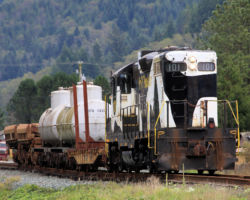
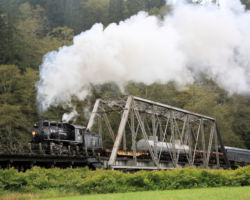
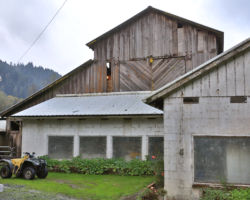
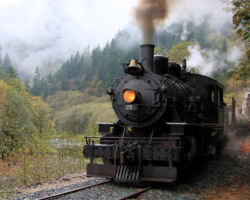
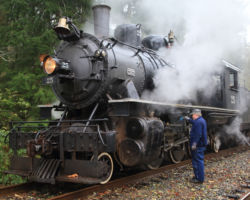
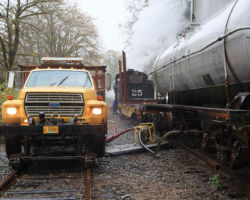
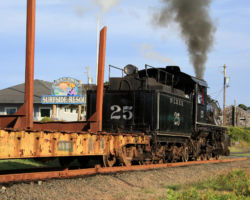
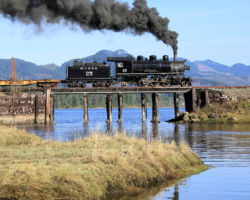
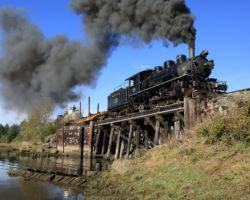
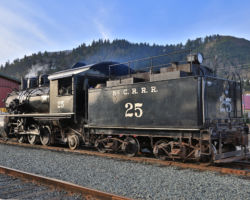
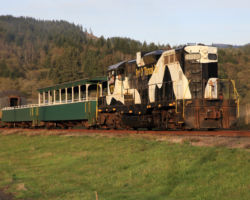
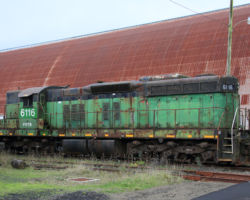
2018 Trip
There were two 2018 OCSR trips scheduled – the first being October 16-18, and the second being October 19-20. The first sold out in less than two days, which was faster than I could actually commit myself to going. Skookum, the rare 2-4-4-2 that had been undergoing restoration at Garibaldi, OR, for years was just about ready to make her first runs. Nobody promised that Skook would be out and about for the trips, but there was always the hope that if it was finished and ran, it would make an appearance. Given my desire to photograph this rare engine out and working, I had no choice – I booked at ticket on the second trip as soon as it was announced.
Unfortunately for all of us, the hopes of seeing a 2-4-4-2 on the road were dashed at the last minute. The engine was back together and fired up when I arrived at Garibaldi, but those initial moves around the Garibaldi yard proved that Skookum still had quite a few bugs to work out. I didn’t see it personally, but apparently something in the alignment or valve gear wasn’t quite right and an eccentric rod got bent. Such are the things that happen when you’re trying to figure out how to rebuild and time a very unique locomotive constructed 100 years ago, and do so without much of the original documentation. My hat’s off to all those involved in the long restoration effort, and a huge thank you for trying. I know it was more disappointing for you than it was for us. At least it was hot and out of the engine house so we could photograph it.
(Side note: I’d finally get to see Skookum in action in early 2020, when it was up and running on the Niles Canyon Railway in California. See “Mallets in Niles Canyon” from Feb 2020.)
Thursday (Oct 19) started off completely socked in with marine layer fog, but that allowed us to work a few angles that wouldn’t have been possible with strong light. We backed the train nearly to Tillamook, photographing near the 101 overpass and the trestles of Hathaway and Stasek Sloughs. From there, we headed up to Wheeler for a few runbys hoping for (and getting) a break in the fog to take advantage of the blue sky and Nehalem Bay. Then it was back to Garibaldi for some sunset shots and night photos after dinner.
Friday dawned blue and perfect, with not a wisp of fog or cloud in sight. To take advantage of the beautiful light and skies, it was straight up to Wheeler again to catch perfect high tide at the Fishery Point bridge. Then once the sun had come over into the afternoon sky, back down to near Tillamook to work the slough trestles again, capped off with a few golden hour shots at Barview.
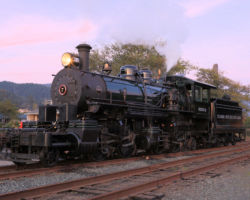
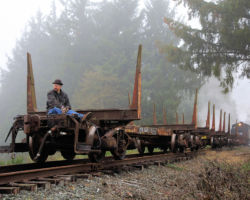
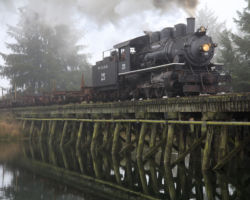
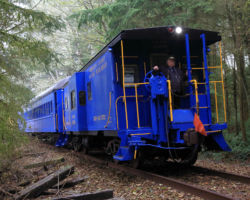
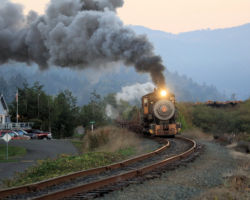
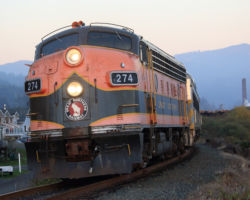
This work is copyright 2024 by Nathan D. Holmes, but all text and images are licensed and reusable under a Creative Commons Attribution-NonCommercial-ShareAlike license. Basically you’re welcome to use any of this as long as it’s not for commercial purposes, you credit me as the source, and you share any derivative works under the same license. I’d encourage others to consider similar licenses for their works.


